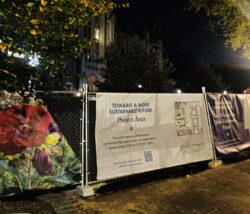The Center for Social Justice held a workshop, led by Assistant Professor of Sociology Brian McCabe (SFS ‘02), on Oct. 28 that examined changing D.C. demographics. The presentation, titled “DC Demographics: The End of Chocolate City?” looked at the forces that affect who lives and works in the District.
The first part of the discussion focused the changing racial composition of the city. Though black residents of D.C. were once in the majority, giving rise to the name “Chocolate City,” they have recently lost this high percentage. The African American share of the population began to rise in the 1950s, when white Washingtonians migrated to the suburbs. In the 1970s, black, middle class families were also able to suburbanize, due to fair housing legislation that prevented housing discrimination based on race.
“This is the story of Washington, D.C., right?” asked McCabe. “But it’s also the story of many, many cities . . . this story of white flight and the black middle class leaving.”
McCabe also discussed immigration into the District and the rise of Latino and Asian populations. “13.5 percent of the D.C. population is foreign born … Compared to other cities you might think of, the share of the population that’s foreign born is much smaller.”
Cities like Los Angeles, New York, and Boston have much more sizable foreign-born shares of the population, up to 35 percent, according to McCabe. El Salvador is the largest country of origin for D.C. immigrants. The neighborhoods of Columbia Heights and Adams Morgan have the highest prevalence of foreign-born residents, but are losing a Latino population due to gentrification, McCabe noted.
Neighborhoods gentrify when residents with high socioeconomic status move into places that have been historically cheap. Rent and the cost of living usually increase, and poorer residents often find themselves displaced. This often leads to racial turnover, as black or ethnic neighborhoods become white dominant. “That’s largely true, but not always true. There are neighborhoods in other cities where there’s an African American middle class that moves out of the city, then they move back into the city, for the same reason that other gentrifiers do,” said McCabe.
According to McCabe, housing prices suggest that D.C. is gentrifying faster than other cities of similar size. In the last decade, young, educated, childless adults, like Georgetown graduates, McCabe pointed out, have been moving back into the District, leading to gentrification.
On the question of how to prevent displacement, McCabe noted programs to assist people in paying for their housing including voucher programs, rent control, and subsidies.





